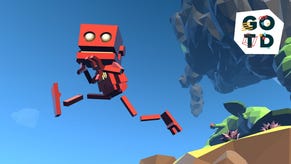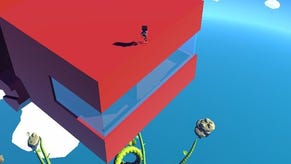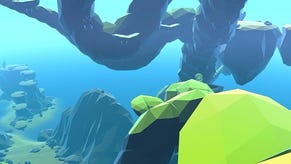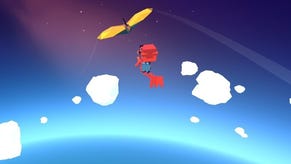Grow Home review
The roots that clutch.
Eurogamer has dropped review scores and replaced them with a new recommendation system. Read the editor's blog to find out more.
It can be hard to remember the precise moment that you fall in love with a game, but it's comparatively easy to remember the moment you realise - yes! - that the game you love is truly worth it. Night had fallen, and I was down by the shore, under the shadow of a huge, soaring vine. The sea was still - the sea is always still - but at the edge of the bay I could spy a cluster of objects bobbing around. Two of them in particular stood out to me: football-sized lumps of green stuff, glowing gently in the dark. That's the moment. I love Grow Home. And it's worth it.
I hope it's not a spoiler to say that when Grow Home's short campaign reaches its dizzying conclusion, you're left to explore the entire map and - if you wish - hunt down eight little doodads that have been freshly scattered over it as sort of a grand finale. The doodads are seeds, football-sized lumps of green stuff, and they could be anywhere. Six of them didn't give me much trouble, but the last two - one perched in a cactus, one rolling in the crater of an asteroid - got away from me. They really got away from me, actually: 2000 metres of getting away. They both ended up in the sea, and the sea in Grow Home is deadly. Uselessly, I watched them float about for a bit and then I clambered back to the spots where I'd found them. Safe bet, right? They're probably on a timer, and they're probably going to regenerate.
They didn't regenerate, though, not even when I saved and quit and then reloaded everything. Wait! Why would they regenerate? They're in the sea. Working a hunch, I went down to a quiet inlet at the heart of the map. I looked to the horizon, and then those seeds wobbled into view before brushing up on the sand. Of course!
Systems integrity might not seem like the most striking element of a game's design, but it increasingly could be, and it absolutely gets to the heart of why Grow Home in particular is so special - why it's a children's game built with a real understanding of how a child's world should operate. Reflections has constructed this strange and wonderful curio around the physics-driven animation system that sees BUD, the game's robot hero, tumbling endlessly over himself as he goes about his job as a sort of extraterrestrial gardener. The game's central mission has him nurturing a vine up out of the golden earth and high into the sky as he waits for it to sprout seeds, but the fun of this derives from the gloriously physical way he interacts with the world, and the gloriously physical world that is always calling out for interaction. The physics gives the world a peculiar honesty, which is more fun than it sounds. This is a game you can trust.
A collection of weighted limbs and body parts drawn together by stretchy forces, BUD's part tumbling, staggering drunk, and part long-limbed hopping toad. What he really is, in other words, is a toddler: huge eyes taking everything in, a rocket strapped to his back in place of a rucksack that might carry a battered lunch box or a doll.
If BUD's a child, then Grow Home's single, varied, and wonderfully generous map is a garden for him to knock about in, and we all know how children feel about gardens. It helps that this one is magical: islands float in the sky, encouraging you to reach them, waterfalls send streams flowing swiftly into the abyss. You start this game on the sand and you end it poking around asteroids. In between lurk wonderful grottoes to uncover (it's a truly great video game moment when you stumble across your first), nutty semi-familiar wildlife to provoke, and crazy science fiction plants, some ready to snap you in half, others aching to blast you high into the air in a friendly stream of neon goop.
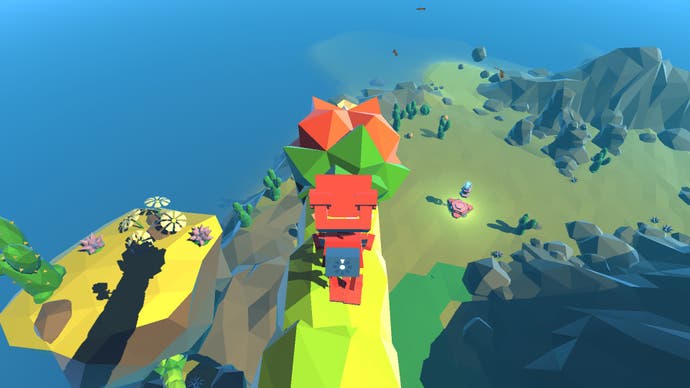
Like the creators of Mario 64, one of a handful of games that Grow Home can't help but remind you of - Crackdown is inevitably another - the developers realise that if you build the right landscapes, the fun will turn up. The second tier of floating islands is a case in point. There's a mountain range, with a snow-covered peak, and there's a hole through the centre of the earth where you can jump from rock to rock as water races past you. Towards the edge, the ground starts to fray rather playfully, gaping holes hidden by rust-coloured trees until you're jumping from one lonely spar of turf to the next. There's nothing you have to do here, as such, which suggests that everything is equally worth doing. I cleared the campaign in two hours, and you will probably do it even more quickly, but I've subsequently spent the best part of a day on this single chunk of real estate, and much more in the world beyond.
Tying all this together is the vine that BUD is here to nurture, a thick, coiling, muscular presence covered in little shoots that you can scamper on to and then trigger into growth, holding tight desperately as they race off into the distance. You can steer these sproutlings - the idea is to connect them to a series of glowing islands in order to send the main stem of the plant spiralling even higher into the sky - but they have a bit of personality to them, a bit of fight. What this means for the pace of the game is that every few moments, you're off on the back of a bucking bronco. What it means for the texture of the game is that there's an ideal balance between the world you're given to explore and the world you can create as you go. By the time the adventure was finished, I felt true ownership of the landscape. I hadn't built the waterfalls or scattered the forests over the rocks, but I had threaded the sky with a hundred crazy green highways, looping across empty space to connect boulders, or terminating, accidentally, in the middle of nowhere.
All of this would be useless if you couldn't get around, and here's where BUD emerges as the centre of the experience again. Taking a leaf from games like QWOP or Surgeon Simulator, an initially bewildering control scheme sees you directing the tiny red robot around with the stick, and then using the triggers or the bumpers to control his left and right hands, grasping and ungrasping as you apply and release pressure. Unlike QWOP or Surgeon Simulator, though, this is not a system in place to create a comedy of cruel awkwardness. Practise your pincering and you can move through the world with real skill, each grasp, each grip, making this colourful low-poly landscape one of the most tactile playgrounds in video games, and bringing the map's highest spaces within reach.
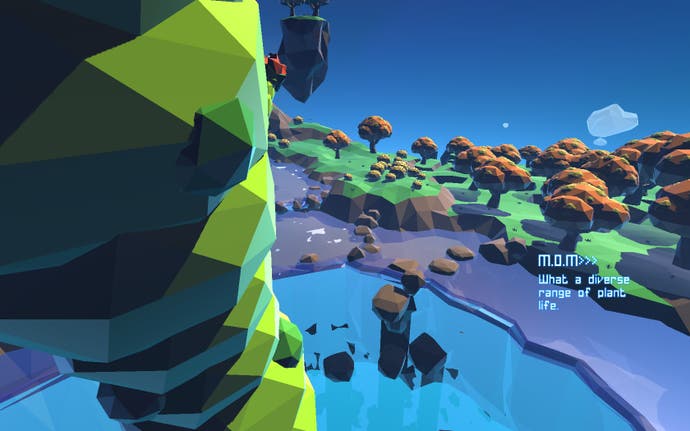
It's utterly empowering, and the controls, working with the physics simulation that gives the game its sense of trustworthiness, ensure that Grow Home is the best rock-climbing game I have ever played. I've spent hours scampering under cliffs, hanging by a single limb, snapping a screenshot and then moving on. What initially drives your exploration may not be anything particularly special - for the most part you're trying to nurse that central vine, or you're scampering around to collect 100 shards of crystal that unlock power-ups lfor your jetpack - but the sense of movement is so gloriously real, so uncompromised by trickery, that traversal is ultimately its own reward.
There's more, of course: witty, evocative audio that sees BUD squeaking and chattering like a 56k modem while the vine creaks and rumbles to itself beneath him, ominous and organic. There's the art style which uses simple colours and those low-poly models to create a world that's beautiful, playful, and also filled with the information you need to navigate it safely. It offers the cheery geometrical intricacy you get in the planes that make up a crumpled ball of paper. There's just enough threat, with a few dangerous plants and a fall that will kill you unless you grasp hold of something before hitting the ground, and there's a gentle upsurge of skymindedness that gathers force as you unlock more jetpack power, or tame plants that allow you to glide, or to fall at your leisure.
Mostly, though, there's the wonderful sense of generous, open-ended fun that comes from the convergence of physics and a vertiginous playground, that comes from a game that I suspect has built itself outwards from its central character, one entertaining decision at a time, with no thought for how this will fit into a tidy framework. Climbing and collecting - that's a lot of Ubisoft games these days, right? But Grow Home feels like it's from the Ubisoft that gave us From Dust. (It doesn't hurt - although it is surprising - that it's actually from the Ubisoft that gave us the relentlessly upbeat Driver: San Francisco.)
Free from the claustrophobic Fordism that increasingly robs series like Assassin's Creed of their sense of wonder, this is a game that's taken shape at its own pace, and that has been allowed to find its own voice. Pick a point to aim for and jump. Jump!







